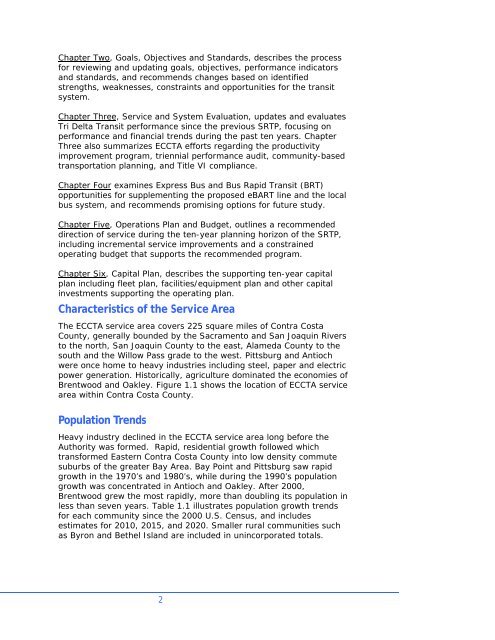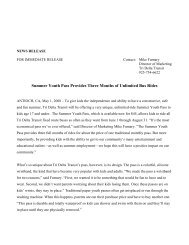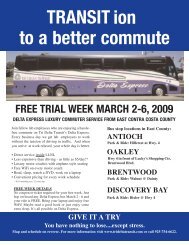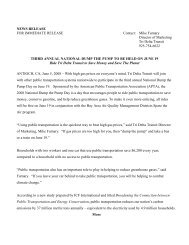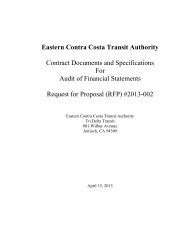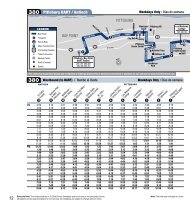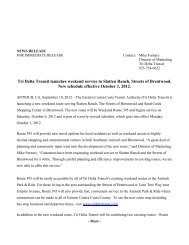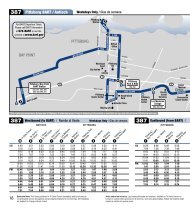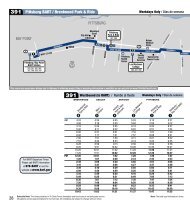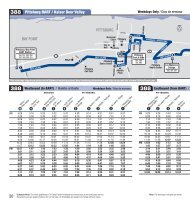to view Short Range Transit Plan FY 2007/2008 - Tri Delta Transit
to view Short Range Transit Plan FY 2007/2008 - Tri Delta Transit
to view Short Range Transit Plan FY 2007/2008 - Tri Delta Transit
Create successful ePaper yourself
Turn your PDF publications into a flip-book with our unique Google optimized e-Paper software.
Chapter Two, Goals, Objectives and Standards, describes the processfor re<strong>view</strong>ing and updating goals, objectives, performance indica<strong>to</strong>rsand standards, and recommends changes based on identifiedstrengths, weaknesses, constraints and opportunities for the transitsystem.Chapter Three, Service and System Evaluation, updates and evaluates<strong>Tri</strong> <strong>Delta</strong> <strong>Transit</strong> performance since the previous SRTP, focusing onperformance and financial trends during the past ten years. ChapterThree also summarizes ECCTA efforts regarding the productivityimprovement program, triennial performance audit, community-basedtransportation planning, and Title VI compliance.Chapter Four examines Express Bus and Bus Rapid <strong>Transit</strong> (BRT)opportunities for supplementing the proposed eBART line and the localbus system, and recommends promising options for future study.Chapter Five, Operations <strong>Plan</strong> and Budget, outlines a recommendeddirection of service during the ten-year planning horizon of the SRTP,including incremental service improvements and a constrainedoperating budget that supports the recommended program.Chapter Six, Capital <strong>Plan</strong>, describes the supporting ten-year capitalplan including fleet plan, facilities/equipment plan and other capitalinvestments supporting the operating plan.Characteristics of the Service AreaThe ECCTA service area covers 225 square miles of Contra CostaCounty, generally bounded by the Sacramen<strong>to</strong> and San Joaquin Rivers<strong>to</strong> the north, San Joaquin County <strong>to</strong> the east, Alameda County <strong>to</strong> thesouth and the Willow Pass grade <strong>to</strong> the west. Pittsburg and Antiochwere once home <strong>to</strong> heavy industries including steel, paper and electricpower generation. His<strong>to</strong>rically, agriculture dominated the economies ofBrentwood and Oakley. Figure 1.1 shows the location of ECCTA servicearea within Contra Costa County.Population TrendsHeavy industry declined in the ECCTA service area long before theAuthority was formed. Rapid, residential growth followed whichtransformed Eastern Contra Costa County in<strong>to</strong> low density commutesuburbs of the greater Bay Area. Bay Point and Pittsburg saw rapidgrowth in the 1970’s and 1980’s, while during the 1990’s populationgrowth was concentrated in Antioch and Oakley. After 2000,Brentwood grew the most rapidly, more than doubling its population inless than seven years. Table 1.1 illustrates population growth trendsfor each community since the 2000 U.S. Census, and includesestimates for 2010, 2015, and 2020. Smaller rural communities suchas Byron and Bethel Island are included in unincorporated <strong>to</strong>tals.2


